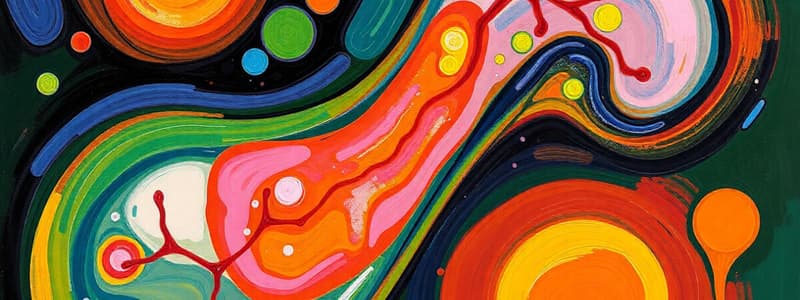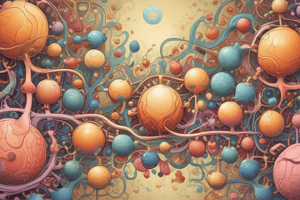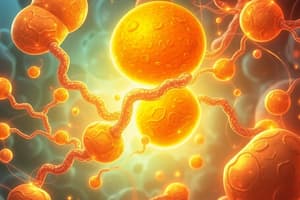Podcast
Questions and Answers
How many NADH molecules are formed during the β oxidation of Palmitoyl-CoA?
How many NADH molecules are formed during the β oxidation of Palmitoyl-CoA?
What is the total yield of ATP from one molecule of Palmitoyl-CoA oxidation?
What is the total yield of ATP from one molecule of Palmitoyl-CoA oxidation?
Which enzyme produces FADH2 during the oxidation of Palmitoyl-CoA?
Which enzyme produces FADH2 during the oxidation of Palmitoyl-CoA?
Considering the ATP yield from NADH and FADH2, how much ATP is generated from 7 FADH2 molecules?
Considering the ATP yield from NADH and FADH2, how much ATP is generated from 7 FADH2 molecules?
Signup and view all the answers
What is the number of ATP produced from the isocitrate dehydrogenase enzyme during the citric acid cycle?
What is the number of ATP produced from the isocitrate dehydrogenase enzyme during the citric acid cycle?
Signup and view all the answers
What effect does PKA have on glycogen synthase?
What effect does PKA have on glycogen synthase?
Signup and view all the answers
What is the role of glycerol kinase in fat metabolism?
What is the role of glycerol kinase in fat metabolism?
Signup and view all the answers
How does fatty acyl-CoA form from fatty acids?
How does fatty acyl-CoA form from fatty acids?
Signup and view all the answers
What happens to fatty acids shorter than 12 carbons in the mitochondria?
What happens to fatty acids shorter than 12 carbons in the mitochondria?
Signup and view all the answers
Which process occurs after the conversion of glycerol to glycerol-3-phosphate?
Which process occurs after the conversion of glycerol to glycerol-3-phosphate?
Signup and view all the answers
What stimulates the conversion of fatty acyl-CoA back to fatty acids inside the mitochondria?
What stimulates the conversion of fatty acyl-CoA back to fatty acids inside the mitochondria?
Signup and view all the answers
What is the effect of PKA on glycolysis?
What is the effect of PKA on glycolysis?
Signup and view all the answers
Which transporter aids in the mitochondrial import of fatty acids?
Which transporter aids in the mitochondrial import of fatty acids?
Signup and view all the answers
What is the primary product generated during the oxidative conversion of fatty acids to acetyl-CoA in Stage 1 of fatty acid oxidation?
What is the primary product generated during the oxidative conversion of fatty acids to acetyl-CoA in Stage 1 of fatty acid oxidation?
Signup and view all the answers
What is the primary advantage of fats over polysaccharides as an energy source?
What is the primary advantage of fats over polysaccharides as an energy source?
Signup and view all the answers
Which enzyme is responsible for the dehydrogenation step in the β-oxidation pathway?
Which enzyme is responsible for the dehydrogenation step in the β-oxidation pathway?
Signup and view all the answers
Which system do chylomicrons enter before draining into large veins?
Which system do chylomicrons enter before draining into large veins?
Signup and view all the answers
What is the net result of the thiolysis reaction in Stage 4 of fatty acid oxidation?
What is the net result of the thiolysis reaction in Stage 4 of fatty acid oxidation?
Signup and view all the answers
How does the oxidation of unsaturated fatty acids differ from saturated fatty acids in terms of FADH2 production?
How does the oxidation of unsaturated fatty acids differ from saturated fatty acids in terms of FADH2 production?
Signup and view all the answers
How are fatty acids primarily carried in the blood after being released from adipocytes?
How are fatty acids primarily carried in the blood after being released from adipocytes?
Signup and view all the answers
What percentage of energy needs does oxidation of fatty acids meet for the mammalian heart and liver?
What percentage of energy needs does oxidation of fatty acids meet for the mammalian heart and liver?
Signup and view all the answers
What role does NAD play in the β-oxidation pathway?
What role does NAD play in the β-oxidation pathway?
Signup and view all the answers
What role do medium chain triglycerides (MCTs) play in drug delivery?
What role do medium chain triglycerides (MCTs) play in drug delivery?
Signup and view all the answers
Which isoform of acyl-CoA dehydrogenase is involved in the oxidation of fatty acids with 12–18 carbons?
Which isoform of acyl-CoA dehydrogenase is involved in the oxidation of fatty acids with 12–18 carbons?
Signup and view all the answers
What does MAG lipase (MGL) specifically hydrolyze?
What does MAG lipase (MGL) specifically hydrolyze?
Signup and view all the answers
In the β-oxidation pathway, what does the step involving enoyl-CoA hydratase produce?
In the β-oxidation pathway, what does the step involving enoyl-CoA hydratase produce?
Signup and view all the answers
Which molecule is formed from the overall process of fatty acid oxidation via the citric acid cycle?
Which molecule is formed from the overall process of fatty acid oxidation via the citric acid cycle?
Signup and view all the answers
Which type of animals primarily rely on stored fatty acids for energy during hibernation?
Which type of animals primarily rely on stored fatty acids for energy during hibernation?
Signup and view all the answers
Which transport mechanism do fatty acids utilize to enter myocytes after leaving serum albumin?
Which transport mechanism do fatty acids utilize to enter myocytes after leaving serum albumin?
Signup and view all the answers
Flashcards
Lipid Metabolism
Lipid Metabolism
The process of digesting, mobilizing, and oxidizing fats (lipids) and synthesizing them from other molecules for energy production and other biological functions.
Fatty Acid Oxidation
Fatty Acid Oxidation
A major energy source, crucial for organs like the heart and liver, obtaining energy from fatty acids.
Chylomicrons
Chylomicrons
Packages for transporting hydrophobic lipid molecules in the bloodstream.
Fatty Acid Mobilization
Fatty Acid Mobilization
Signup and view all the flashcards
Fat Storage Efficiency
Fat Storage Efficiency
Signup and view all the flashcards
Apolipoproteins
Apolipoproteins
Signup and view all the flashcards
Myocyte Fatty Acid Oxidation
Myocyte Fatty Acid Oxidation
Signup and view all the flashcards
Dietary Triacylglycerol (TAG)
Dietary Triacylglycerol (TAG)
Signup and view all the flashcards
PKA's effect on glycogen metabolism
PKA's effect on glycogen metabolism
Signup and view all the flashcards
PKA's effect on Glycolysis
PKA's effect on Glycolysis
Signup and view all the flashcards
Glycerol's entry into glycolysis
Glycerol's entry into glycolysis
Signup and view all the flashcards
Fatty acid transport to mitochondria
Fatty acid transport to mitochondria
Signup and view all the flashcards
Fatty Acyl-CoA formation
Fatty Acyl-CoA formation
Signup and view all the flashcards
Fatty acid transport (large)
Fatty acid transport (large)
Signup and view all the flashcards
Fatty acid transport into mitochondria (small)
Fatty acid transport into mitochondria (small)
Signup and view all the flashcards
Acyl-carnitine/carnitine transporter
Acyl-carnitine/carnitine transporter
Signup and view all the flashcards
β-Oxidation
β-Oxidation
Signup and view all the flashcards
Acyl-CoA dehydrogenase
Acyl-CoA dehydrogenase
Signup and view all the flashcards
β-Hydroxyacyl-CoA dehydrogenase
β-Hydroxyacyl-CoA dehydrogenase
Signup and view all the flashcards
NADH and FADH2 in ATP production
NADH and FADH2 in ATP production
Signup and view all the flashcards
How many ATP from Palmitoyl-CoA oxidation?
How many ATP from Palmitoyl-CoA oxidation?
Signup and view all the flashcards
Fatty Acid Oxidation Stages
Fatty Acid Oxidation Stages
Signup and view all the flashcards
Beta-oxidation
Beta-oxidation
Signup and view all the flashcards
Enoyl-CoA Hydratase
Enoyl-CoA Hydratase
Signup and view all the flashcards
Beta-hydroxyacyl-CoA dehydrogenase
Beta-hydroxyacyl-CoA dehydrogenase
Signup and view all the flashcards
Acyl-CoA acetyltransferase (thiolase)
Acyl-CoA acetyltransferase (thiolase)
Signup and view all the flashcards
Unsaturated Fatty Acid Oxidation
Unsaturated Fatty Acid Oxidation
Signup and view all the flashcards
Fatty Acid Oxidation Location
Fatty Acid Oxidation Location
Signup and view all the flashcards
Study Notes
Lipid Metabolism
- One-third of energy needs come from dietary triacylglycerols (TAGs).
- Fatty acid oxidation is a major energy source.
- 80% of mammalian heart and liver energy needs are met by fatty acid oxidation.
Hibernating Animals and Polar Bears
- Hibernating animals and land-locked polar bears get most of their energy from stored fatty acids.
Fats vs. Polysaccharides
- Fats carry more energy per carbon because they are more reduced.
- Fats carry less water because they are nonpolar.
- Glucose and glycogen are for short-term energy needs with rapid delivery.
- Fats are for long-term energy needs, good storage, and slow delivery over months.
Mobilization of Dietary Fats
- Dietary fats are packaged into chylomicrons in the small intestine.
- Bile salts emulsify dietary fats, forming mixed micelles.
- Intestinal lipases degrade triacylglycerols.
- Fatty acids and other breakdown products are incorporated into triacylglycerols, then into chylomicrons with cholesterol and apolipoproteins.
- Chylomicrons move through lymphatic system and bloodstream to tissues.
- Lipoprotein lipase, activated by apoC-ll, converts triacylglycerols to fatty acids and glycerol.
Lipids and Transport
- Lipids are hydrophobic and need packaging for transport in the blood.
- Chylomicrons are formed with triacylglycerols, cholesteryl esters, cholesterol, and phospholipids, along with apolipoproteins.
- Chylomicrons are released into the intestinal lymphatic system, then into large veins, and delivered throughout the body.
Avoiding Hepatic Metabolism
- Small lipophilic drugs packaged with long chain triglycerides can be incorporated into chylomicrons and carried to the lymph, then bloodstream, avoiding the liver.
- MCT = medium chain triglycerides
- GML = glyceryl monolinoleate (a long chain triglyceride)
- SEDDS = self-emulsifying formula made with GML
Lipoproteins
- Hydrophobic lipids are packaged with apolipoproteins in the blood for transport.
- Chylomicrons (density < 0.95 gm/ml): very large, carry lipid from intestine to periphery (100-1000 nm).
- VLDL (density 0.95-1.0 gm/ml): large, carry lipid from liver to periphery.
- LDL (density 1.00-1.06 gm/ml): carry cholesterol to periphery.
- HDL (density 1.06-1.2 gm/ml): smallest, carries cholesterol back to the liver.
Lipases and Glycerol
- Lipases cleave fatty acids from glycerol in the backbone of triacylglycerols.
- Glycerol kinase phosphorylates glycerol using ATP.
- Glycerol enters glycolysis after phosphorylation.
Intracellular Transport
- Fatty acids are converted to fatty acyl-CoA for intracellular transport.
- Fatty acid + CoASH + ATP fatty acyl-CoA + AMP + PPi
- The reaction is catalyzed by fatty acyl-CoA synthetase.
Fatty Acid Oxidation and Mitochondria
- Fats and triglycerides are decomposed to fatty acids and glycerol in the cytoplasm of adipocytes.
- Fatty acids are transported to other tissues via the blood.
- Fatty acids are oxidized in mitochondria.
- Small fatty acids (less than 12 carbons) diffuse across mitochondrial membranes freely.
- Large fatty acids use a carnitine/acyl-carnitine transporter.
Acyl-Carnitine/Carnitine Transporter
- Carnitine acyltransferase 1 attaches fatty acid to carnitine, forming fatty acyl carnitine.
- Fatty acyl carnitine diffuses across the outer mitochondrial membrane (OMM).
- Fatty acyl carnitine crosses into the matrix by counter-exchange with carnitine.
- Carnitine acyltransferase 2 reattaches fatty acid to CoA.
Fatty Acid Oxidation Stages
- Stage 1: Oxidative conversion of 2-carbon units to acetyl-CoA via β-oxidation, generating NADH and FADH2.
- Stage 2: Oxidation of acetyl-CoA into CO2 via the citric acid cycle, producing NADH and FADH2.
- Stage 3: ATP production from NADH & FADH2 via oxidative phosphorylation.
β-Oxidation Pathway
- Removal of acetyl groups in the form of acetyl-CoA.
- Steps of oxidation, hydration, oxidation, and thiolysis are involved.
Oxidation of Unsaturated Fatty Acids
- Results in one fewer FADH2, after isomerization, and 1 FADH2 is produced during the first step of the next cycle.
- NADPH reduces the remaining unsaturated bond, making sure there's no further loss of FADH2.
NADH and FADH2 in ATP Production
- NADH and FADH2 are used as sources of ATP.
- Specific enzymes catalyze the oxidation steps in β-oxidation.
- The final amount of ATP produced varies, based on the steps in the process.
Hormone Regulation
- Glucagon and epinephrine activate lipases, triggering the mobilization of stored triacylglycerols when blood glucose is low.
- PKA phosphorylates hormone-sensitive lipase (HSL) causing perilipin to dissociate and exposing stored triacylglycerols.
- ATGL converts triacylglycerol (TAG) to diacylglycerol (DAG).
- P-HSL converts DAG to monoacylglycerol (MAG).
- MAG lipase (MGL) converts monoacylglycerol (MAG) to glycerol and fatty acids.
- Fatty acids enter myocytes and undergo oxidation via the citric acid cycle for ATP production.
Glycogen Metabolism and PKA
- PKA regulates multiple pathways to maintain glucose homeostasis, including inhibition of glycogen synthase, activation of glycogen phosphorylase kinase (glycogen breakdown).
- PKA inhibits glycolysis, including pyruvate kinase.
- PKA activates fatty acid metabolism, including hormone-sensitive lipase, so the body uses fat as an energy source.
Glycerol in Glycolysis
- Glycerol kinase phosphorylates glycerol.
- After oxidation, the phosphorylated glycerol molecule enters glycolysis.
- Glycerol entry into glycolysis allows for limited anaerobic catabolism of fats.
Studying That Suits You
Use AI to generate personalized quizzes and flashcards to suit your learning preferences.
Related Documents
Description
This quiz explores the intricacies of lipid metabolism, examining how dietary fats are utilized for energy in both mammals and hibernating animals. It highlights the differences between fats and polysaccharides in energy storage and delivery, emphasizing the significance of fatty acid oxidation. Test your understanding of these concepts and their implications for energy needs.




